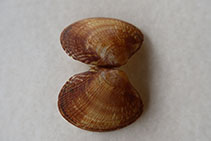Ruditapes philippinarum (Adams & Reeve, 1850)
Japanese carpet shell
Classification / Names Common names | Synonyms | CoL | ITIS | WoRMS
Bivalvia | Venerida | Veneridae
Environment: milieu / climate zone / depth range / distribution range Ecology
Benthic; brackish; pH range: 13.5 - 35.0; depth range 0 - 100 m (Ref. 356). Tropical; ? - 35°C (Ref. 104360), preferred 18°C (Ref. 107945); 56°N - 11°S, 75°E - 164°E (Ref. 348)
Distribution Countries | FAO areas | Ecosystems | Occurrences | Introductions
Indo-Pacific and the Mediterranean: from India and Sri Lanka to Micronesia; north to Sakhalin, the Japan Sea and Hawaii (introduced), and south to Indonesia. Introduced in the Northeast Atlantic.
Length at first maturity / Size / Weight / Age
Maturity: Lm 2.7 range ? - ? cm Max length : 8.0 cm SHL male/unsexed; (Ref. 348); common length : 5.0 cm SHL male/unsexed; (Ref. 348); max. reported age: 14 years (Ref. 104360)
Introduced incidentally with Japanese oysters (Crassostrea gigas), or for aquaculture trials, in many areas (Ref. 348). Found in littoral to sublittoral sediments (Ref. 1314). Intertidal and upper subtidal flats (Ref. 106937). Common in protected marine areas (Ref. 348). With short siphons and buries to only about 10 cm deep in a variety of substrates, from mud, sand, and gravel, high along intertidal areas (Refs. 95344, 104238). Occasionally overlaps with Zostera japonica beds or Zostera marina beds in the intertidal (Ref. 106937). Suspension feeder. Diet includes phytoplankton (Refs. 104238, 104360), benthic diatoms, and terrestrial organic matter (Ref. 104238).
Life cycle and mating behavior Maturity | Reproduction | Spawning | Eggs | Fecundity | Larvae
Broadcast spawners. Life cycle: Embryos develop into free-swimming trocophore larvae, succeeded by the bivalve veliger (with ciliated vellum to assist mobility and feeding), resembling a miniature clam. After 2-4 weeks, it develops into a peliveliger with a formed foot to assist further with swimming, as well as byssal threads to help the clam secure itself onto the seafloor once it finds a suitable substrate to settle on. Burrowing into the ground allows the animal to find food and be protected from predators. Once settled, it will stay in the substrate and continue to grow into a mature clam.
Main reference
References | Coordinator | Collaborators
SAUP Database. 2006. (Ref. 356)
IUCN Red List Status (Ref. 130435)
CITES status (Ref. 108899)
Not Evaluated
CMS (Ref. 116361)
Not Evaluated
Threat to humans
Human uses
Fisheries: commercial
FAO - Aquaculture: production, species profile; Fisheries: landings, species profile | FishSource | Sea Around Us
Tools
More information
Internet sources
BHL | BOLD Systems | CISTI | DiscoverLife | FAO(Aquaculture: species profile; Fisheries: species profile; publication : search) | Fishipedia | GenBank (genome, nucleotide) | GloBI | Gomexsi | Google Books | Google Scholar | Google | PubMed | Tree of Life | Wikipedia (Go, Search) | Zoological Record
Estimates based on models
Preferred temperature
(Ref. 115969): 15.7 - 29.1, mean 28.2 (based on 1790 cells).
Resilience
(Ref. 69278):
High, minimum population doubling time less than 15 months (K=0.3-0.91; tm=1.5; tmax=14).
Prior r = 1.19, 95% CL = 0.79 - 1.79, Based on 1 data-limited stock assessment.
Nutrients: Calcium = 149 [71, 228] mg/100g; Iron = 8.53 [1.95, 15.11] mg/100g; Protein = 9.88 [8.64, 11.12] %; Omega3 = 0.313 [0.202, 0.423] g/100g; Selenium = 61 [50, 72] μg/100g; VitaminA = 0 μg/100g; Zinc = 2.04 [0.56, 3.51] mg/100g (wet weight).



